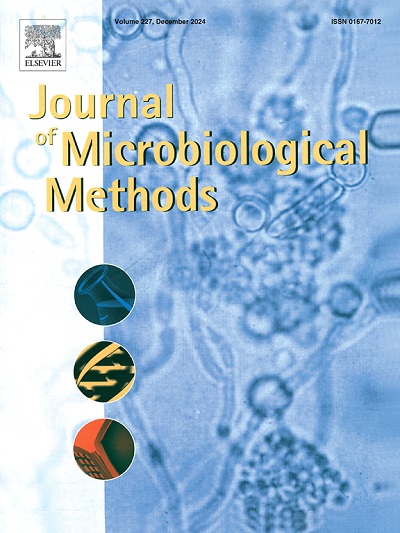硝化抑制剂的高通量筛选试验和甲状腺素作为生物硝化抑制剂的发现
IF 1.9
4区 生物学
Q4 BIOCHEMICAL RESEARCH METHODS
引用次数: 0
摘要
硝化抑制剂在减少农业肥料的氮(N)损失,提高肥料利用效率和减少其对环境和气候的影响方面具有重要价值。目前,已批准的抑制剂组合有限,这就产生了对新替代品的强烈需求。传统的硝化抑制试验依赖于大型土壤系统,批量培养,或者充其量是在深孔96孔板中进行微生物培养,这些都不适合高通量筛选。在这里,我们提出了一种高度可靠的方法,可以快速有效地筛选土壤传播的氨氧化细菌europaea亚硝化单胞菌和多形亚硝化螺旋体上的数千个分子。我们的检测方法使用384孔板进行筛选和读出,每个样品只需要50 μL的培养物和少量的化合物。该分析还允许进一步表征硝化抑制剂,并区分针对氨单加氧酶(AMO)和羟胺氧化还原酶(HAO)途径的抑制剂。最后,我们应用该方法测试了几种恶唑烷变体,发现甲状腺素是一种新的生物硝化抑制剂(BNI)。总的来说,该分析为快速鉴定新型硝化抑制剂提供了有前途的工具,有助于可持续农业。本文章由计算机程序翻译,如有差异,请以英文原文为准。
High-throughput screening assay for nitrification inhibitors and the discovery of goitrin as a biological nitrification inhibitor
Nitrification inhibitors are valuable in mitigating nitrogen (N) losses from agricultural fertilizers, enhancing fertilizer use efficiency, and minimizing their environmental and climatic impacts. Currently, the portfolio of approved inhibitors is limited, creating a strong demand for new alternatives. Traditional nitrification inhibition assays rely on large soil systems, batch cultures, or, at best, microbial cultures in deep-well 96-well plates, none of which are suited for high-throughput screening. Here, we present a highly robust method that enables rapid and efficient screening of thousands of molecules on the soil-borne ammonia-oxidizing bacteria Nitrosomonas europaea and Nitrosospira multiformis. Our assay utilizes 384-well plates for both screening and read-out, requiring only 50 μL of culture per sample and low amounts of compound. The assay also allows for further characterization of nitrification inhibitors and differentiation between those targeting the ammonia monooxygenase (AMO) and hydroxylamine oxidoreductase (HAO) pathways. Finally, we applied the assay to test several oxazolidine variants and discovered goitrin as a novel biological nitrification inhibitor (BNI). Overall, this assay offers promising tools for the rapid identification of novel nitrification inhibitors, contributing to sustainable agriculture.
求助全文
通过发布文献求助,成功后即可免费获取论文全文。
去求助
来源期刊

Journal of microbiological methods
生物-生化研究方法
CiteScore
4.30
自引率
4.50%
发文量
151
审稿时长
29 days
期刊介绍:
The Journal of Microbiological Methods publishes scholarly and original articles, notes and review articles. These articles must include novel and/or state-of-the-art methods, or significant improvements to existing methods. Novel and innovative applications of current methods that are validated and useful will also be published. JMM strives for scholarship, innovation and excellence. This demands scientific rigour, the best available methods and technologies, correctly replicated experiments/tests, the inclusion of proper controls, calibrations, and the correct statistical analysis. The presentation of the data must support the interpretation of the method/approach.
All aspects of microbiology are covered, except virology. These include agricultural microbiology, applied and environmental microbiology, bioassays, bioinformatics, biotechnology, biochemical microbiology, clinical microbiology, diagnostics, food monitoring and quality control microbiology, microbial genetics and genomics, geomicrobiology, microbiome methods regardless of habitat, high through-put sequencing methods and analysis, microbial pathogenesis and host responses, metabolomics, metagenomics, metaproteomics, microbial ecology and diversity, microbial physiology, microbial ultra-structure, microscopic and imaging methods, molecular microbiology, mycology, novel mathematical microbiology and modelling, parasitology, plant-microbe interactions, protein markers/profiles, proteomics, pyrosequencing, public health microbiology, radioisotopes applied to microbiology, robotics applied to microbiological methods,rumen microbiology, microbiological methods for space missions and extreme environments, sampling methods and samplers, soil and sediment microbiology, transcriptomics, veterinary microbiology, sero-diagnostics and typing/identification.
 求助内容:
求助内容: 应助结果提醒方式:
应助结果提醒方式:


